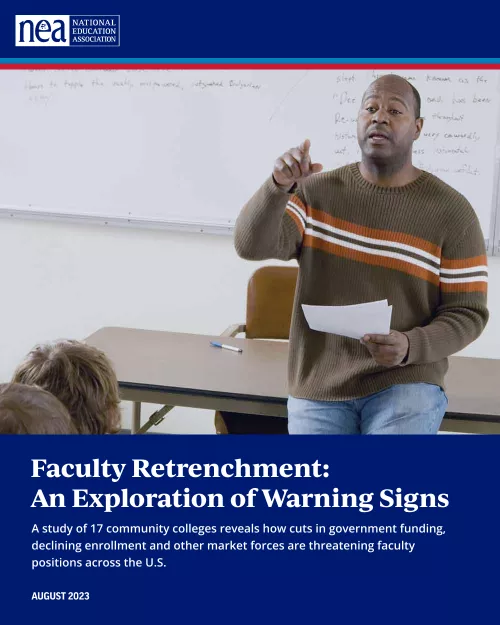Key Takeaways
- Enrollment declines, changing labor force demands and changes in government funding have forced colleges to restructure their academic programs, service offerings, and delivery; often these efforts target faculty positions.
- Across all U.S. community colleges, the number of faculty declined 5 percent over the past 10 years, with two in three community colleges experiencing faculty declines averaging 17 percent.
- In the face of a restructuring event, faculty should be given the opportunity to work with administrators to find opportunities to realign their expertise to new programs and/or be reassigned in lieu of being laid off.
Introduction
Last summer, the National Education Association (NEA) developed a New Business Item to explore retrenchment: “The NEA shall make a statistical study on the effect of significant faculty retrenchment at community colleges on future faculty cuts” (NBI 78, 2022). National Education Association Representative Assembly. (2022, July 7). Amendments to the constitution, bylaws, and standing rules. RA Today, 5. nea.org/sites/default/files/2022-07/2022RAToday_Issue5.pdf Go to reference Various definitions for retrenchment exist, but it is generally viewed as a reduction in programs and/or services, which results in the termination of employment due to financial exigency; some institutions also view retrenchment as reductions related to “changes in institutional missions, substantial program changes, or major reallocations of resources for academic or support services.” Retrenchment—402.59. (n.d.). UA Little Rock, Policy. ualr.edu/policy/home/facstaff/retrenchment/ Go to reference
ASA Research (ASA) conducted exploratory research in an attempt to identify warning characteristics, or patterns in the characteristics, of colleges that experience retrenchment. For the first phase of this research, ASA conducted a scan of journals, news articles, websites, and other publicly available documents to identify community colleges that experienced retrenchment in the past 10 years. ASA identified community colleges that underwent or are beginning to implement structural changes (e.g., elimination of departments or programs) that led or will lead to the elimination of faculty positions. For the second phase, ASA assessed trends in colleges’ enrollment and finance metrics to identify metrics to use to warn of a potential coming retrenchment event. And, comparing changes in faculty numbers for examined colleges and all community colleges, ASA estimated what may be considered “significant” loss in faculty during retrenchment.
- 1 National Education Association Representative Assembly. (2022, July 7). Amendments to the constitution, bylaws, and standing rules. RA Today, 5. nea.org/sites/default/files/2022-07/2022RAToday_Issue5.pdf
- 2 Retrenchment—402.59. (n.d.). UA Little Rock, Policy. ualr.edu/policy/home/facstaff/retrenchment/



